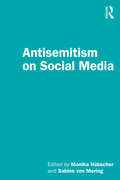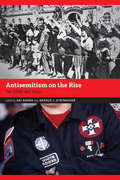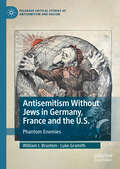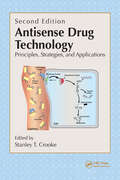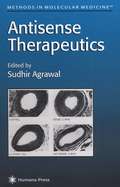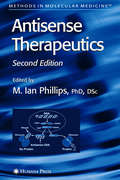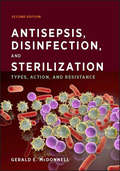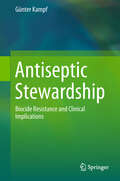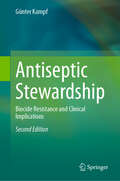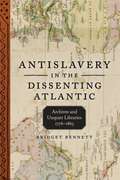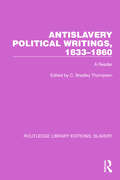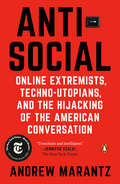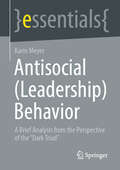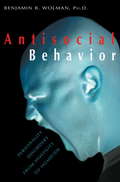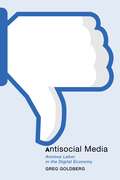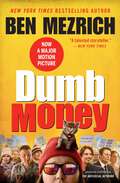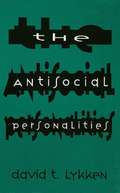- Table View
- List View
Antisemitism in Reader Comments: Analogies for Reckoning with the Past (Postdisciplinary Studies in Discourse)
by Matthias J. BeckerThis book examines the most frequent form of Jew-hatred: Israel-related antisemitism. After defining this hate ideology in its various manifestations and the role the internet plays in it, the author explores the question of how Israel-related antisemitism is communicated and understood through the language used by readers in below-the-line comments. Drawing on a corpus of over 6,000 comments from traditionally left-wing news outlets The Guardian and Die Zeit, the author examines both implicit and explicit comparisons made between modern-day Israel and both colonial Britain and Nazi Germany. His analyses are placed within the context of resurgent neo-nationalism in both countries, and it is argued that these instances of antisemitism perform a multi-faceted role in absolving guilt, re-writing history, and reinforcing in-group status. This book will be of interest not only to linguistics scholars, but also to academics in fields such as internet studies, Jewish studies, hate speech and antisemitism.
Antisemitism, Islamophobia and the Politics of Definition (Palgrave Critical Studies of Antisemitism and Racism)
by David Feldman Marc VoloviciThis book, the first to explore the politics of definitions from an interdisciplinary perspective, encourages readers to reconsider the value and limits of definitions in confronting antisemitism and Islamophobia. In recent years, definitions of antisemitism and Islamophobia have become central to the struggle to combat the hostility, harassment and discrimination experienced by Jews and Muslims. Yet these definitions have also provoked fierce controversy: critics have questioned whether they are fit for purpose, or have criticised them as unwelcome attempts to restrict freedom of expression. In this edited collection, historians, social scientists and philosophers reflect on definitions of antisemitism and Islamophobia in both the past and the present. Its contributors investigate the different historical contexts which have shaped definitions and examine their different political purposes and meanings, as well as addressing contemporary debates, and identifying ways for us to move beyond our current impasse. This book therefore provides a broad and new perspective from which to comprehend present day minority politics.
Antisemitism on Social Media
by Monika Hübscher and Sabine von MeringAntisemitism on Social Media is a book for all who want to understand this phenomenon. Researchers interested in the matter will find innovative methodologies (CrowdTangle or Voyant Tools mixed with discourse analysis) and new concepts (tertiary antisemitism, antisemitic escalation) that should become standard in research on antisemitism on social media. It is also an invitation to students and up-and-coming and established scholars to study this phenomenon further. This interdisciplinary volume addresses how social media with its technology and business model has revolutionized the dissemination of antisemitism and how this impacts not only victims of antisemitic hate speech but also society at large. The book gives insight into case studies on different platforms such as Twitter, Facebook, TikTok, YouTube, and Telegram. It also demonstrates how social media is weaponized through the dissemination of antisemitic content by political actors from the right, the left, and the extreme fringe, and critically assesses existing counter-strategies. People working for social media companies, policy makers, practitioners, and journalists will benefit from the questions raised, the findings, and the recommendations. Educators who teach courses on antisemitism, hate speech, extremism, conspiracies, and Holocaust denial but also those who teach future leaders in computer technology will find this volume an important resource.
Antisemitism on the Rise: The 1930s and Today (Contemporary Holocaust Studies)
by Ari Kohen Gerald J. SteinacherWe live in uncertain and unsettling times. Tragically, today&’s global culture is rife with violent bigotry, nationalism, and antisemitism. The rhetoric is not new; it is grounded in attitudes and values from the 1930s and the 1940s in Europe and the United States.Antisemitism on the Rise is a collection of essays by some of the world&’s leading experts, including Joseph Bendersky, Jean Cahan, R. Amy Elman, Leonard Greenspoon, and Jürgen Matthäus, regarding two key moments in antisemitic history: the interwar period and today. Ari Kohen and Gerald J. Steinacher have collected important examples on this crucial topic to illustrate new research findings and learning techniques that have become increasingly vital with the recent rise of white supremacist movements, many of which have a firm root in antisemitism. Part 1 focuses on the antisemitic beliefs and ideas that were predominant during the 1930s and 1940s, while part 2 draws comparisons between this period and today, including examples of ways to teach others about contemporary antisemitism. The volume seeks to inform readers about the historical progression of antisemitism and in doing so asks readers to think about what is at stake and how to bridge the gap between research and teaching.
Antisemitism Without Jews in Germany, France and the U.S.: Phantom Enemies (Palgrave Critical Studies of Antisemitism and Racism)
by William I. Brustein Luke GramithWhy does antisemitic messaging strike a chord in certain communities without Jews but fall flat in neighboring communities equally without Jews? This book focuses on antipathy towards Jews - expressed through successful electoral campaigns where a candidate or political party championed antisemitism - in communities located in three different nations where the Jewish population had virtually no history of interaction with the resident majority population of non-Jews. The cases are: the election of antisemitic deputies in the 1893 German Reichstag Elections from eastern Saxony; the election of a slate of antisemitic deputies to the French Chamber in 1898 from the southwestern French department of the Gers; and the significant proportion of votes for the antisemitic campaign of Gerald B. Winrod in the U.S. Senate Republican Party primary election in 1938 in Kansas. Each of these examples illustrates the existence of heightened levels of antisemitism in cases where few, if any, Jews had engagement with the majority population.
Antisense Drug Technology: Principles, Strategies, and Applications, Second Edition
by Stanley T. CrookeExtensively revised and updated, Antisense Drug Technology: Principles, Strategies, and Applications, Second Edition reflects the logarithmic progress made in the past four years of oligonucleotide-based therapies, and, in particular, antisense therapeutics and research. Interpreting lessons learned from the clinical trials of first generati
Antisense RNA Design, Delivery, and Analysis (Methods in Molecular Biology #2434)
by Virginia Arechavala-Gomeza Alejandro GarantoThis open access volume gathers a variety of models, delivery systems, and approaches that can be used to assess RNA technology for exploiting antisense as a therapeutic intervention. Beginning with a section on the design of antisense technology and their delivery, the book continues by covering model systems developed to evaluate efficacy, both in vivo and in vitro, as well as methods to evaluate preclinically the toxicity associated with these new potential drugs, and intellectual property considerations. Written for the highly successful Methods in Molecular Biology series, chapters include introductions to their respective topics, lists of the necessary materials and reagents, step-by-step, readily reproducible laboratory protocols, and tips on troubleshooting and avoiding known pitfalls. Authoritative and practical, Antisense RNA Design, Delivery, and Analysis provides basic knowledge and a large collection of methods to facilitate the work of newcomers to this vibrant and expanding field. This book was conceived thanks to the network DARTER (Delivery of Antisense RNA Therapeutics). DARTER is funded by the EU Cooperation of Science and Technology (COST), which aims to enhance interaction and collaborations between researchers in Europe and other countries.
Antisense Therapeutics (Methods in Molecular Medicine #1)
by Sudhir AgrawalLeading researchers offer an authoritative survey and analysis of the latest findings on the rapid development of antisense oligonucleotides therapeutic and their application in various in vivo model systems. The book's high-profile contributors provide timely accounts of their state-of-the-art strategies, discussing such topics as the synthesis and purification of oligonucleotides, their selection for a particular gene target, different methods of administration, and the use of various cell lines and cell culture systems. They also examine questions of cellular uptake, in vitro biological activity, in vivo biological activity, the pharmacology and pharmacokinetics of oligonucleotides, and the application of oligonucleotides to the central nervous system.
Antisense Therapeutics (Methods in Molecular Medicine #106)
by M. Ian PhillipsA timely primer on the new reality of antisense and RNA inhibition for treating a broad range of diseases. The authors show how antisense oligonucleotides are being designed and studied in relation to hypertension, various cancers, inflammatory bowel disease, brain disorders, the blood-brain barrier, and drug delivery. Highlights include RNA-based therapies for many diseases, up-to-date methods and applications, and insight into the enormous potential to provide a new generation of drugs.
Antisepsis, Disinfection, and Sterilization: Types, Action, and Resistance (ASM Books)
by Gerald McDonnellAntisepsis, Disinfection, and Sterilization: Types, Action, and Resistance, by Gerald E. McDonnell, is a detailed and accessible presentation of the current methods of microbial control. Each major category, such as physical disinfection methods, is given a chapter, in which theory, spectrum of activity, advantages, disadvantages, and modes of action of the methods are thoroughly and clearly presented. Sufficient background on the life cycles and general anatomy of microorganisms is provided so that the reader who is new to microbiology will better appreciate how physical and chemical biocides work their magic on microbes. Other topics in the book include: Evaluating the efficacy of chemical antiseptics and disinfectants, and of physical methods of microbial control and sterilization. Understanding how to choose the proper biocidal product and process for specific applications. Classic physical and chemical disinfection methods, such as heat, cold, non-ionizing radiation, acids, oxidizing agents, and metals. Newer chemical disinfectants, including, isothiazolones, micro-and nano-particles, and bacteriophages as control agents. Antisepsis of skin and wounds and the biocides that can be used as antiseptics. Classic methods of physical sterilization, such as, moist heat and dry heat sterilization, ionizing radiation, and filtration, along with newer methods, including, the use of plasma or pulsed light. Chemical sterilization methods that use ethylene oxide, formaldehyde, or a variety of other oxidizing agents. A detailed look at the modes of action of biocides in controlling microbial growth and disrupting microbial physiology. Mechanisms that microorganisms use to resist the effects of biocides. The second edition of Antisepsis, Disinfection, and Sterilization: Types, Action, and Resistance is well suited as a textbook and is outstanding as a reference book for facilities managers and application engineers in manufacturing plants, hospitals, and food production facilities. It is also essential for public health officials, healthcare professionals, and infection control practitioners.
Antiseptic Stewardship: Biocide Resistance and Clinical Implications
by Günter KampfVarious antiseptic agents, such as chlorhexidine, are used for different applications, e.g. in healthcare, veterinary medicine, animal production and household products, including cosmetics. However, not all antiseptic agents provide significant health benefits, especially in some products used in human medicine (alcohol-based hand rubs, antimicrobial soaps). While some products (antimicrobial soaps, surface disinfectants, instrument disinfectants, wound antiseptics) may contain one or more biocidal agents with a comparable antimicrobial efficacy but large differences in their potential for microbial adaptation and tolerance. An increased bacterial resistance has been described for various antimicrobial agents, sometimes including a cross-resistance to antibiotics. The book is the first comprehensive reference resource on antiseptic agents, including their efficacy, natural and acquired resistance, adaptation, and cross-resistance. It also discusses their and appropriate use in terms of a balance between their efficacy and the risk of acquired bacterial resistance / tolerance. Focusing on human and veterinary medicine and household products, it helps readers make informed decisions concerning against antiseptic products based on their composition. The book contributes to reduce any unnecessary selection pressure towards emerging pathogens and to keep the powerful antiseptic agents for all those applications that have a clear benefit (e.g. reduction of healthcare-associated infection).
Antiseptic Stewardship: Biocide Resistance and Clinical Implications
by Günter KampfThis updated and expanded second edition of Antiseptic Stewardship serves as a comprehensive reference guide to common biocidal active substances and antiseptic agents, examining their antimicrobial efficacy and potential to induce cell tolerance, including cross-tolerance to other biocidal agents, as well as cross-resistance to antibiotics. In addition, the book discusses the appropriate and targeted use of biocidal active substances by balancing their expected health benefits against the likelihood of clinically relevant resistance, including misuse and overuse of some products during the COVID-19 pandemic. This guide, which focuses on human, veterinary and household products, helps readers make informed decisions about disinfectants and antiseptic products based on their composition. Various biocidal active substances and antiseptic agents are used for disinfection and antisepsis in healthcare, veterinary medicine, animal production and household products. However, not all of them provide significant health benefits, especially for some products used in human medicine. Antimicrobial soaps, surface disinfectants, instrument disinfectants and wound antiseptics may contain one or more biocidal active ingredients with comparable antimicrobial efficacy, but with large differences in their potential for microbial adaptation and tolerance. Increased bacterial tolerance has been described for several biocidal active substances and antiseptics, sometimes including cross-resistance to antibiotics. The book is therefore intended to help reduce unnecessary selection pressure on emerging pathogens, including by describing non-biocidal alternatives for specific antimicrobial applications, with the aim of retaining the powerful biocidal agents and antiseptics for those applications where there is a clear health benefit (e.g. reduction of healthcare-associated infections). The book addresses healthcare, industrial and veterinary professionals as well as educated laypersons interested in efficient and controlled disinfection strategies.
Antislavery in the Dissenting Atlantic: Archives and Unquiet Libraries, 1776–1865 (Antislavery, Abolition, and the Atlantic World)
by Bridget BennettBridget Bennett’s Antislavery in the Dissenting Atlantic explores the impact of a historically situated set of transatlantic networks, chiefly centered on prominent communities of religious nonconformists in England and Pennsylvania in the decades between the American Revolution and American Civil War. The study reveals the alliances forged out of progressive religious and political commitments to dissent that enabled expansive connections across the Atlantic world. These developments emerged from local proximities and combined an optimistic devotion to social justice and education with a global vision. Bennett’s work offers an original and innovative reading of transatlantic partnerships, exploring obscure writings, overlooked individuals, and the cultures of the everyday, while also affording fresh understandings of familiar antislavery texts.
Antislavery Political Writings, 1833–1860: A Reader (Routledge Library Editions: Slavery #3)
by Thompson C. BradleyAntislavery Political Writings, first published in 2004, presents the best speeches and writings of the leading American antislavery thinkers, activists and politicians in the years between 1830 and 1860. These chapters demonstrate the range of theoretical and political choices open to antislavery advocates during the antebellum period.
Antisocial
by Jillian BlakeWhat if your greatest secrets became public? For the students at Alexandria Prep, a series of hacks leads to a scandalous firestorm—and the students are left wondering whose private photos and messages will be exposed next. It’s Pretty Little Liars meets WikiLeaks.Senior spring at Alexandria Prep was supposed to be for sleeping through class and partying with friends. But for Anna Soler, it’s going to be a lonely road. She's just been dumped by her gorgeous basketball star boyfriend—with no explanation. Anna's closest friends, the real ones she abandoned while dating him, are ignoring her. The endearing boy she’s always had a complicated friendship with is almost too sympathetic. But suddenly Anna isn’t the only one whose life has been upended. Someone is determined to knock the kings and queens of the school off their thrones: one by one, their phones get hacked and their personal messages and photos are leaked. At first it's funny—people love watching the dirty private lives of those they envy become all too public. Then the hacks escalate. Dark secrets are exposed, and lives are shattered. Chaos erupts at school. As Anna tries to save those she cares about most and to protect her own secrets, she begins to understand the reality of our always-connected lives: Sometimes we share too much.
Antisocial: Online Extremists, Techno-Utopians, and the Hijacking of the American Conversation
by Andrew MarantzFrom a rising star at The New Yorker, a deeply immersive chronicle of how the optimistic entrepreneurs of Silicon Valley set out to create a free and democratic internet--and how the cynical propagandists of the alt-right exploited that freedom to propel the extreme into the mainstream. <P><P>For several years, Andrew Marantz, a New Yorker staff writer, has been embedded in two worlds. The first is the world of social-media entrepreneurs, who, acting out of naïvete and reckless ambition, upended all traditional means of receiving and transmitting information. The second is the world of the people he calls "the gate crashers"--the conspiracists, white supremacists, and nihilist trolls who have become experts at using social media to advance their corrosive agenda. <P><P>Antisocial ranges broadly--from the first mass-printed books to the trending hashtags of the present; from secret gatherings of neo-Fascists to the White House press briefing room--and traces how the unthinkable becomes thinkable, and then how it becomes reality. Combining the keen narrative detail of Bill Buford's Among the Thugs and the sweep of George Packer's The Unwinding, Antisocial reveals how the boundaries between technology, media, and politics have been erased, resulting in a deeply broken informational landscape--the landscape in which we all now live. <P><P>Marantz shows how alienated young people are led down the rabbit hole of online radicalization, and how fringe ideas spread--from anonymous corners of social media to cable TV to the President's Twitter feed. Marantz also sits with the creators of social media as they start to reckon with the forces they've unleashed. Will they be able to solve the communication crisis they helped bring about, or are their interventions too little too late?
Antisocial: A Brief Analysis from the Perspective of the "Dark Triad" (essentials)
by Karin MeyerNarcissism is considered a widespread phenomenon at leadership levels, where it is represented disproportionately compared to the general population. Furthermore, younger emerging (leadership) talents exhibit significantly higher levels of narcissism than older generations have shown to date. At the same time, traits of the Dark Triad (narcissism, machiavellianism, and psychopathy) often do not occur in isolation, but rather in combination. For this reason, companies should rethink their personnel selection, management, and development practices today. This analysis will therefore highlight the characteristics and behavior patterns of ruthless individuals from the Dark Triad, as well as possible approaches for intervention and prevention.
Antisocial Behavior
by Benjamin B. WolmanAntisocial behavior takes on many forms, from rebellious teens with green hair and pierced skin to the truly dangerous homicidal individuals whose horrible stories fill our newspapers. Parents worry about their children as they are exposed to the heatedclimate of violence in contemporary society, a time of decaying morals and values.The rise in sociopathic behavior among adults and children, whether in tense inner cities or in tranquil suburban and rural settings, is masterfully chronicled by Dr. Benjamin B. Wolman, a leading psychologist and noted national expert who has studied these trends for over half a century. "There is a growing incidence of sociopathic antisocial behavior . . . coupled with an attitude of moral apathy," Dr. Wolman asserts. He cites international statistics pointing to a showdown between dangerous individuals-the violent, the charming, and the passive-and the societies that create them.How has the spread of democratic ideals actually increased the potential for antisocial behavior? What social and cultural factors must be changed if free societies are to reduce this alarming trend?Rather than simply complain about the problem, Dr. Wolman examines the familial and societal causes, and proposes clear-cut solutions to the problem-including radical changes to our educational system and the mass media.
Antisocial Behavior and Mental Health Problems: Explanatory Factors in Childhood and Adolescence
by Rolf Loeber David P. Farrington Magda Stouthamer-Loeber Welmoet B. Van KammenEpidemiological surveys have provided key information about the prevalence and degree of seriousness at different ages of a wide array of problem behaviors such as delinquency, substance use, early sexual involvement, and mental health disorders. Knowledge of the extent of these problems and changes in their course over time is important. In its absence, interventions and health planning in general can be difficult. Understanding which risk and protective factors are relevant to which problem behaviors is also essential for the formulation of theories that constitute the basis of intervention. This book draws on the results of the major Pittsburgh Youth Study complemented by follow-up tracking of juvenile court records for more than six years, to address the following questions: *What is the prevalence and age of onset of delinquency, substance use, and early sexual behavior for three samples of boys age 8, 11, and 14? What are the average mental health problems for these ages? How strong are the relationships among these problem behaviors in each of the samples? *Which variables best explain individual differences among the boys in their manifestations of delinquency, substance use, early sexual behavior, and mental health problems? To what extent do explanatory factors vary with age? How accurately can boys with different outcomes be identified by risk scores based on hierarchical multiple regressions? *To what extent are explanatory factors associated with one outcome that are also associated with other outcomes? Are explanatory factors that are especially characteristic of a multiproblem group of boys--who display many different problem behaviors--different from explanatory factors associated with boys with few problems? *Do the results fit a general theory of juvenile problem behaviors, or is a differentiated theory more applicable?
Antisocial Media: Anxious Labor in the Digital Economy (Postmillennial Pop #21)
by Greg GoldbergThe debate surrounding the transformation of work at the hands of digital technology and the anxieties brought forth by automation, the sharing economy, and the exploitation of leisure We have been told that digital technology is now threatening the workplace as we know it, that advances in computing and robotics will soon make human labor obsolete, that the sharing economy, exemplified by Uber and Airbnb, will degrade the few jobs that remain, and that the boundaries between work and play are collapsing as Facebook and Instagram infiltrate our free time.In this timely critique, Greg Goldberg examines the fear that work is being eviscerated by digital technology. He argues that it is not actually the degradation or disappearance of work that is so troubling, but rather the underlying notion that society itself is under attack, and more specifically the bonds of responsibility on which social relations depend. Rather than rushing to the defense of the social, however, Goldberg instead imagines the appeal of refusing the hard work of being a responsible and productive member of society.
Antisocial Media: Crime-watching in the Internet Age (Palgrave Studies in Crime, Media and Culture)
by Mark A. WoodThis book provides a cutting-edge introduction to Internet-facilitated crime-watching and examines how social media have shifted the landscape for producing, distributing, and consuming footage of crime. In this thought-provoking work, Mark Wood examines the phenomenon of antisocial media: participatory online domains where footage of crime is aggregated, sympathetically curated, and consumed as entertainment. Focusing on Facebook pages dedicated to hosting footage of street fights, brawls, and other forms of bareknuckle violence, Wood demonstrates that to properly grapple with antisocial media, we must address not only their content, but also their software. In doing so, this study goes a long way to addressing the fundamental question: how have social media changed the way we consume crime? Synthesizing criminology, media theory, software studies, and digital sociology, Antisocial Media is media criminology for the Facebook age. It is essential reading for students and scholars interested in social media, cultural criminology, and the crime-media interface.
Antisocial, Narcissistic, and Borderline Personality Disorders: A New Conceptualization of Development, Reinforcement, Expression, and Treatment
by Daniel J. FoxThis book provides a framework for scholars and clinicians to develop a comprehensive and dynamic understanding of antisocial, narcissistic, and borderline personality disorders, by seeing personality as a dual, as opposed to a singular, construct. Converging the two separate research and clinical diagnostic systems into a wholistic model designed to reach reliable and valid diagnostic conclusions, the text examines adaptive and maladaptive personality development and expression, while addressing the interpersonal system that keeps the pathology from extinguishing. Each chapter will discuss core and surface content, origin and symptom manifestation, system and pathology perpetuation, and online behavior expression, concluding with practical guidance on treatment success and effective approaches. Seasoned and tyro researchers and clinicians will be challenged to explore the utility of the DSM-5 alternative model of personality disorders and apply it to further the understanding of these complex, and often destructive, disorders.
The Antisocial Network: The GameStop Short Squeeze and the Ragtag Group of Amateur Traders That Brought Wall Street to Its Knees
by Ben MezrichFrom one of our most innovative and celebrated authors, the definitive take on the wildest story of the year— the David-vs.-Goliath GameStop short squeeze, a tale of fortunes won and lost overnight that may end up changing Wall Street forever.Bestselling author Ben Mezrich offers a gripping, beat-by-beat account of how a loosely affiliate group of private investors and internet trolls on a subreddit called WallStreetBets took down one of the biggest hedge funds on Wall Street, firing the first shot in a revolution that threatens to upend the establishment.It&’s the story of financial titans like Gabe Plotkin of hedge fund Melvin Capital, one of the most respected and staid funds on the Street, billionaires like Elon Musk, Steve Cohen, Mark Cuban, Robinhood co-CEOs Vlad Tenev and Baiju Bhatt, and Ken Griffin of Citadel Securities. Over the course of four incredible days, each in their own way must reckon with a formidable force they barely understand, let alone saw coming: everyday men and women on WallStreetBets like nurse Kim Campbell, college student Jeremy Poe, and the enigmatic Keith &“RoaringKitty&” Gill, whose unfiltered livestream videos captivated a new generation of stock market enthusiasts.The unlikely focus of the battle: GameStop, a flailing brick-and-mortar dinosaur catering to teenagers and outsiders that had somehow held on as the world rapidly moved online. At first, WallStreetBets was a joke—a meme-filled, freewheeling place to share shoot-the-moon investment tips, laugh about big losses, and post diamond hand emojis. Until some members noticed an opportunity in GameStop—and rode a rocket ship to tens of millions of dollars in earnings overnight.In thrilling, pulse-pounding prose, THE ANTISOCIAL NETWORK offers a fascinating, never-before-seen glimpse at the outsize personalities, dizzying swings, corporate drama, and underestimated American heroes and heroines who captivated the nation during one of the most volatile weeks in financial history. It&’s the amazing story of what just happened—and where we go from here.
The Antisocial Personalities
by David T. LykkenThis volume presents a scholarly analysis of psychopathic and sociopathic personalities and the conditions that give rise to them. In so doing, it offers a coherent theoretical and developmental analysis of socialization and its vicissitudes, and of the role played in socialization by the crime-relevant genetic traits of the child and the skills and limitations of the primary socializing agents, the parents. This volume also describes how American psychiatry's (DSM-IV) category of "Antisocial Personality Disorder" is heterogeneous and fails to document some of the more interesting and notorious psychopaths of our era. The author also shows why the antinomic formula "Nature vs. Nurture" should be revised to "Nature via Nurture" and reviews the evidence for the heritability of crime-relevant traits. One of these traits -- fearlessness -- seems to be one basis for the primary psychopathy and the author argues that the primary psychopath and the hero may be twigs on the same genetic branch. But crime -- the failure of socialization -- is rare among traditional peoples still living in the extended-family environment in which our common ancestors lived and to which our species is evolutionarily adapted. The author demonstrates that the sharp rise in crime and violence in the United States since the 1960s can be attributed to the coeval increase in divorce and illegitimacy which has left millions of fatherless children to be reared by over-burdened, often immature or sociopathic single mothers. The genus sociopathic personality includes those persons whose failure of socialization can be attributed largely to incompetent or indifferent rearing. Two generalizations supported by modern behavior genetic research are that most psychological traits have strong genetic roots and show little lasting influence of the rearing environment. This book demonstrates that the important trait of socialization is an exception. Although traits that obstruct or facilitate socialization tend to obey these rules, socialization itself is only weakly heritable; this is because modern American society displays such enormous variance in the relevant environmental factors, mainly in parental competence. Moreover, parental incompetence that produces sociopathy in one child is likely to have the same result with any siblings. This book argues that sociopathy contributes far more to crime and violence than psychopathy because sociopaths are much more numerous and because sociopathy is a familial trait for both genetic and environmental reasons. With a provocative thesis and an engaging style, this book will be of principal interest to clinical, personality, forensic, and developmental psychologists and their students, as well as to psychiatrists and criminologists.
Antisocial Personality: Theory, Research, Treatment
by Richard Howard Conor Duggan<p>It remains something of a mystery why some individuals behave in persistently malevolent and destructive ways towards their fellows, causing untold harm both to themselves and their victims. This book argues that to understand the roots of antisocial behaviour, one first has to understand what motivates the majority of people to behave prosocially - to think, feel and act in non-malevolent ways. All people are motivated to seek emotion goals - to feel thrilled and excited, to feel safe from the threats of others, to feel a sense of justice, and to feel gratified. However some individuals seek these emotion goals in antisocial ways due to an excess of emotions such as distrust, boredom, greed, vengeance and insecurity. The authors outline interpersonal and neurobiological correlates of antisocial personality, its developmental antecedents, its frequency and pattern across different societies and cultures, and different approaches to its treatment and rehabilitation.</p>


